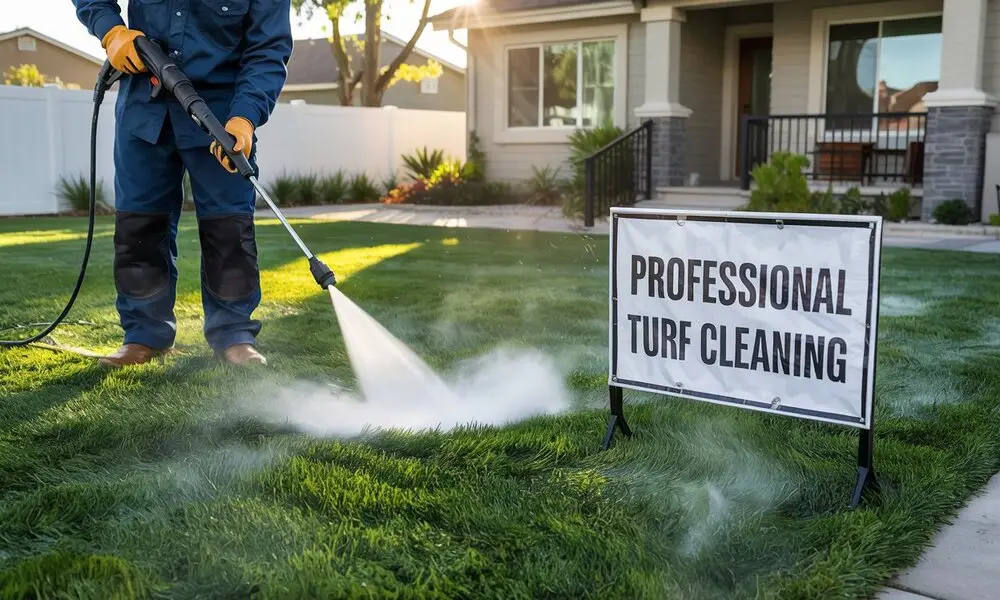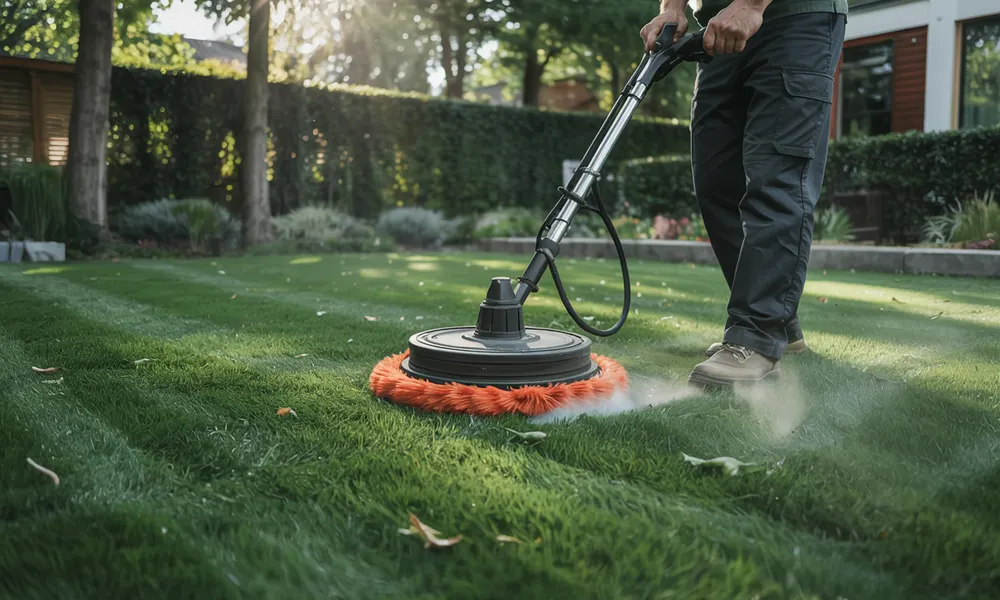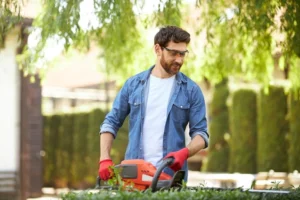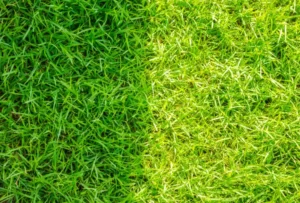How to clean turf grass is a common question among homeowners and pet owners who have chosen artificial turf for its low maintenance and year-round greenery. Artificial turf has gained immense popularity in recent years due to its durability, water-saving benefits, and evergreen appearance, making it a popular choice for lawns, playgrounds, and pet areas.
However, despite its convenience, proper artificial turf cleaning is essential to maintain its hygiene and visual appeal, especially in households with pets. Regular cleaning turf grass routines help prevent odors, bacteria buildup, and the accumulation of pet waste. In this guide, we’ll walk you through five easy steps for effective artificial turf cleaning, with special attention to handling dog urine and solid pet waste to keep your lawn fresh, safe, and inviting.
How to Clean Turf Grass in Five Easy Steps

Keeping your artificial lawn looking great isn’t hard—it just takes a little regular care. Whether you’re dealing with pet waste, dirt, or odors, these five easy steps will show you exactly how to clean turf grass effectively and safely.
Step 1: Get rid of pet waste and solid debris
Start your turf maintenance by removing any solid waste, such as fallen leaves, twigs, or pet feces. For simple cleanup, use a plastic bag or a scooper. Once the solids are removed, rinse the affected area with water to prevent residue from settling into the fibers.
For a deeper level of cleaning turf, especially in pet areas, apply an enzyme-based cleaner. These products break down organic materials and help sanitize without damaging the turf.
Step 2: Rinse with Water Regularly
Frequent rinsing helps remove dust, pollen, and minor spills. For high-use areas or yards with pets, aim to rinse the turf 2–3 times a week. Avoid high-pressure washers, which can break turf fibers or disturb infill, and instead use a regular garden hose with a spray nozzle.
Gentle, consistent rinsing is essential for clean artificial turf and prolongs its appearance and usability.
Step 3: Neutralize Dog Pee Odors
Wondering how to clean turf grass from dog pee? Start with a rinse, then apply a turf-safe enzymatic cleaner or a diluted vinegar solution (1:1 ratio with water). These natural solutions neutralize odors without harming the turf’s backing or fibers.
Avoid using bleach or ammonia—they can break down the structure of artificial grass and pose health risks to pets.
Step 4: Brush and Fluff the Turf
Turf blades may flatten with time due to weather and foot usage. By brushing your grass, you may avoid matting and keep it looking fresh and straight. Make use of a dedicated turf brush or a broom with stiff bristles.
Make brushing part of your monthly cleaning turf routine to keep it looking lush and natural.
Step 5: Deep Clean Periodically
For a more thorough clean, consider vacuuming. Can you vacuum artificial grass? Yes—but only with a turf-safe vacuum or shop vac. Make sure it has adjustable suction and won’t pull up infill or turf fibers.
Alternatively, you can use a power broom or hire professional turf cleaning services for deep sanitation and grooming. Apply a turf deodorizer last to maintain the pleasant scent of your lawn.
You can read about Bay area turf installation service.
Cleaning Pet Waste Off Artificial Turf

Keeping your artificial lawn clean when you have pets is simple with the right approach. Here’s how to tackle cleaning pet waste off artificial turf effectively and safely.
Why It Matters
Pet waste can lead to odor build-up and bacteria growth if not handled quickly. Unlike natural grass, synthetic turf doesn’t absorb waste, so proper artificial turf cleaning is key to preventing lingering smells and hygiene issues.
Step 1: Remove Solid Waste
Use a scooper or disposable bag to pick up solid pet waste. Be thorough to avoid residue being worked into the turf over time.
Step 2: Rinse the Area
Use a garden hose to rinse the area once the garbage has been removed. Regular rinsing helps keep your lawn clean and prevents buildup—especially important when cleaning turf grass in pet-heavy zones.
Step 3: Use Enzyme-Based Cleaners
For deeper artificial turf cleaning, apply a turf-safe, enzyme-based spray. These products are made especially to decompose organic materials and eliminate pet scents. Let it sit for several minutes so it can penetrate and sanitize the area.
Step 4: Scrub Stubborn Spots
If stains or smells persist, use a soft brush or scrubber. Gently scrub the affected area after applying the cleaner to lift any remaining debris or odor-causing matter.
Step 5: Rinse Again Thoroughly
Finish by rinsing the turf well to flush out any leftover cleaner or loosened debris. This maintains the freshness, safety, and aesthetic appeal of your lawn.
You may prolong the life of your artificial lawn and keep it clean by keeping up with routine turf grass cleaning, particularly in places where your pet urinates, odor-free outdoor space.
You can read about How Much Does Artificial Turf Cost.
Pro Tips for Pet Owners
Keeping a synthetic lawn fresh and hygienic when you have pets is all about choosing the right materials and following smart maintenance practices. Here are some expert tips to help you clean artificial turf more efficiently and prevent odor and mess in the first place.
1. Choose Turf with Proper Drainage
When installing your lawn, opt for artificial turf that features a built-in drainage backing. This design allows urine and water to flow through quickly, preventing pooling and reducing odor buildup—making it much easier to clean artificial turf regularly.
2. Use Antimicrobial Infill
Not all infill is created equal. For pet owners, it’s worth investing in infill products that have antimicrobial properties. These help minimize bacteria growth and control odors between cleanings, making your clean artificial turf routine less frequent and more effective.
3. Pick Pet-Friendly Turf Products
Some artificial grass is made specifically for pet use. These options often include stronger fibers, odor control layers, and enhanced drainage—all of which make it easier to maintain and clean artificial turf with minimal hassle.
Final Thoughts
Keeping your lawn fresh and odor-free is easy when you know how to clean turf grass the right way. Regular rinsing, enzyme cleaners, and a solid brushing routine can keep your artificial turf looking like new. For pet owners, choosing the right turf and infill makes all the difference.
Need a deeper clean or expert help? Contact Lakota Design Group for professional turf cleaning and maintenance services. Call us today or request a quote—your lawn deserves the best!
FAQs
1. How Often Should I Clean Turf Grass?
For regular use, rinse your turf once a week. If you have pets or heavy foot traffic, clean more frequently—2–3 times a week is ideal for odor and bacteria control.
2. What’s The Best Way To Clean Turf Grass From Pet Waste?
Remove solid waste with a scooper, rinse the area, then apply an enzyme-based cleaner to break down bacteria and neutralize odors. Finish with another rinse for a thorough clean.
3. Can I Use Household Cleaners On Turf Grass?
Avoid harsh chemicals like bleach or ammonia. Instead, use turf-safe products or a vinegar and water solution to clean turf grass without damaging the fibers or backing.
4. Should I Brush My Turf Regularly?
Yes! Brushing helps fluff up flattened blades and keeps your turf looking fresh. Use a stiff-bristled broom or turf brush monthly, or more often in high-traffic areas.
5. Can I Vacuum Artificial Turf For Deep Cleaning?
Yes, but only with a turf-safe vacuum or shop vac. For best results, consider using a power broom or professional turf cleaning service.





